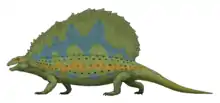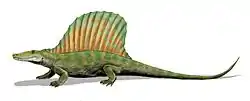Clepsydrops
Clepsydrops is an extinct genus of primitive synapsids from the early Late Carboniferous that was related to Archaeothyris. The name means 'hour-glass appearance' (Greek klepsydra = "hourglass" + Greek ops = "eye, face, appearance").[1]
| Clepsydrops Temporal range: Carboniferous | |
|---|---|
| Scientific classification | |
| Kingdom: | Animalia |
| Phylum: | Chordata |
| Family: | †Ophiacodontidae |
| Genus: | †Clepsydrops Cope, 1875 |
| Species | |
| |
| Synonyms | |
| |
Synapsida is the group (or clade) that includes mammals, but the term is mainly used to refer to its earliest members. Like many other early terrestrial amniotes, it probably had the diet of insects and smaller animals. It probably laid eggs on land rather than in the water, as most amniote tetrapods did.
A paleobiological inference model for the femur suggests a terrestrial lifestyle for Clepsydrops,[2] as for its more recent relative Ophiacodon.[3] This is consistent with its rather thin, compact cortex. Its jaws were slightly more advanced than those of other early amniote tetrapods like Paleothyris and Hylonomus.
See also
- List of pelycosaurs
- Evolution of mammals
- Carboniferous tetrapods
- List of transitional fossils
References
- http://dinosaurmailinglist.cmnh.org/2016Jun/msg00013.html
- Quémeneur, S.; de Buffrénil, V.; Laurin, M. (2013). "Microanatomy of the amniote femur and inference of lifestyle in limbed vertebrates". Biological Journal of the Linnean Society. 109 (3): 644–655. doi:10.1111/bij.12066.
- Laurin, M.; de Buffrénil, V. (2015). "Microstructural features of the femur in early ophiacodontids: A reappraisal of ancestral habitat use and lifestyle of amniotes". Comptes Rendus Palevol. 15 (1–2): 115–127. doi:10.1016/j.crpv.2015.01.001.




